Text
(Un)Filtered, Unplugged
Filtering wine is a touchy subject for some. Unfiltered wines are very popular in the market right now and it's almost obligatory to bottle your wine unfiltered if you're choosing to market yourself as a small, boutique winery. The reason for this is that some believe that when you filter a wine you rob it of its uniqueness and its character: metaphorically castrating the liquid in the bottle. If you’ve read Kermit Lynch’s acclaimed novel “Adventures on the Wine Route” you have a good idea of how some of the winemaking and wine consuming population feel about it. For those who haven’t here is a short excerpt describing two identical wines, one filtered and one unfiltered from Domaine Vieux Télégraphe, one of Mr. Lynch’s more famous imports from Châteauneuf-du-Pape,
“The filtered smelled as clean as it looked, but what little nose it had seemed superficial compared to the unfiltered, and it gave an impression of fatigue, which is not illogical because filtration involves pumping, or pushing, the wine through a long series of cardboardlike plaques… The unfiltered had a deep healthy aroma. One might say its aroma had texture; it seemed dense and full of nuances of spice and fruit. It smelled as good as the wine fresh out of the foudre.”
In this scenario the wines were tasted blind by Mr. Lynch and the whole staff at Vieux Télégraphe and the unfiltered wine declared the unanimous winner. However, this book was published in 1988 and therefore the wines tasted years before the book was even published, begging the question, “What would the results be if this test were replicated using today’s technology?” This leads me to the point of this increasingly lengthy rant: The idea that one wine is superior to another only because one was filtered and one was not is a false notion created by one’s own mind.
This debate wasn’t much of a debate until very recently: only groups of winemakers, sommeliers or enthusiasts of opposite camps swearing that their idea was the correct one. A sensory test is easy enough to conduct; a winery just has to save some bottles of unfiltered wine each year to compare to those that receive the regular filtered treatment. Multiple replicates including both older and younger vintages would give the experiment more credibility. Well, this is exactly what the entire crew (and a few unsuspecting guests) did at Donelan Family Wines this year after harvest concluded.
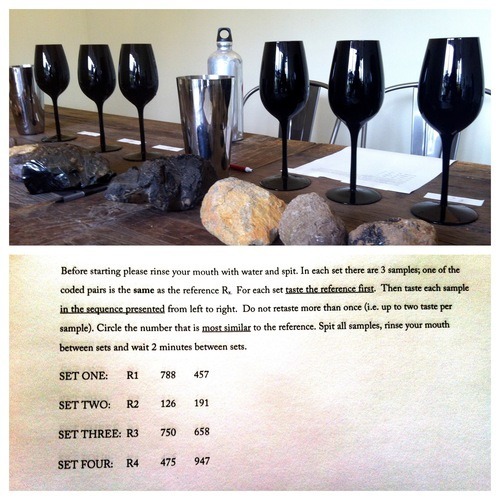
(The set up that was used to conduct our Filtered vs. Unfiltered experiment and the written guidelines that were laid out for us)
Four replicates of the same wine were assembled in sets of three: one reference and two glasses each assigned a random number. The object was to guess which of the numbered glasses was the same as the reference. As an added hurdle, the wines were tasted in black glasses so no differences in particulate matter could sway decision-making. This test was repeated with five different wines from the Donelan lineup over a five-day period. With a choice between two wines your results must be significantly higher than 50% in order to show that there was a difference that could be smelled or tasted in the wine that led you to make your decision, otherwise it would be akin to flipping a coin. The results of the test showed that out of 60 replicates there were exactly 30 correct responses, I personally went 10/20. These results proved to the staff at Donelan Family Wines that they were making the correct decision to filter their wines as another means of protection against spoilage from threats like Brettanomyces.
This test, while educational, may not be the hard scientific proof that some people crave to come to a final conclusion. For that we go to the lab of David Block of the enology department at the University of California, Davis. His findings are much too complex to explain here, but there is a short video and Powerpoint of his presentation that I highly recommend watching. The long and short of it is that Block conducted a much more controlled, thorough and extensive study with many more replicates than we did at Donelan and came up with (and is continuing to come up with) some quantifiable data that shows the same results. He explains that those components in wine that are responsible for flavor, aroma, body, texture and so forth, are smaller than the 0.45 micron filters that are used in modern wineries today and that the only effect that filtration has on a wine is an increase in visual clarity and microbial stability.
I’m sure the argument will continue, but this definitely arms those pro-filtering winemakers with some solid scientific evidence to support their decisions to do so. I have nothing against unfiltered wines; I have had several that I thoroughly enjoyed and believe that the decision to filter or not is part of a winemaking philosophy that adds variety to the business that we are in. However, those that perpetually seek the truth must find it in themselves to adapt from time to time in order to better themselves and their products.
2 notes
·
View notes
Text
Fermentation Nation
It is so strange that the livelihoods of so many people rest on the existence and activities of a single celled fungus: yeast. Wine, beer, spirits, sake, kombucha, bread, sauerkraut and other foods and beverages all depend upon yeast merely existing and doing the only two things it is able to do; feed and multiply. However, even something as seemingly simple as a single celled organism can support unbelievable diversity. Scientists estimate that there are over 1,500 different species of yeasts, which in turn have numerous different strains and it is said that we have only identified one percent of all of this. Of the many different species and strains that constantly surround us only a few of them are suited to fermentation of foods and beverages.
Before we discuss which yeasts ferment our favorite foods and drinks we should discuss how. Yeast is a fairly low maintenance organism; all it asks is for a clean working environment with bountiful amounts of sugar to consume along with some other minerals, amino and fatty acids to keep it functioning healthfully. Much like we do when we eat, yeast produces byproducts, in this case in the form of carbon dioxide, heat, alcohol and esters (responsible for some aromas and flavors). Different species and strains of yeast create different amounts of these byproducts and are adept at working under different conditions, which is why we use them for different reasons.
Saccharomyces cerevisiae is the golden boy of the yeast world. This is the species that bakers rely upon to make their bread rise, the species that winemakers who conduct native fermentations allow to turn grape must into wine and it is known as “top-fermenting” yeast in breweries (forming a layer on top and preferring warmer temperatures for working) and is responsible for the production of ales. S. cerevisiae is very reliable, predictable, durable, produces a high amount of esters and a low amount of off aromas or flavors in most circumstances. It also occurs naturally everywhere even on the skins of grapes in the vineyards.
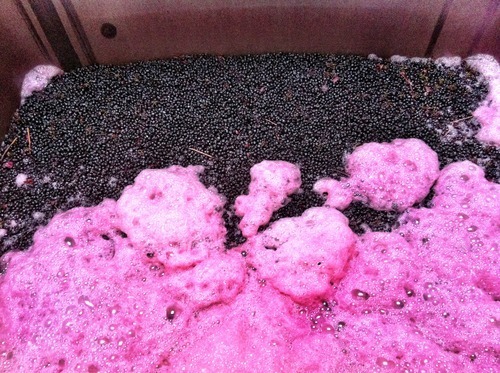
(Saccharomyces cerevisiae working on a small fermentation tank filled with Syrah from the Russian River Valley of California)
The second major style of beer, lagers, requires a different species of yeast; Saccaromyces pastorianus. This yeast prefers cooler temperatures for its work and settles at the bottom of the fermenting wort (unfermented beer) which is why it is called “bottom-fermenting” yeast by brewmasters and enthusiasts alike. As a result of these lower temperatures, S. pastorianus works more slowly and produces a lower level of byproducts such as alcohol and esters, which is why lagers tend to be lower in alcohol and less aromatic than ales, opting for crisp and refreshing instead.
We have already talked about our next yeast to some point when discussing flaws in wine. Brettanomyces, commonly shortened to “Brett” is an interesting yeast because while it is considered a flaw by many it is absolutely depended on for the production of Lambic beers, sour ales and also many styles of Belgian beer. Brettanomyces is an extremely hearty yeast that is capable of surviving in extremely inhospitable conditions as far as other yeasts are concerned. Scientific studies have show that Brett can survive and multiply on a mere 0.7 grams of sugar per liter in wine. The legal limit for “dryness” (meaning the threshold under which most humans can’t detect sweetness) is 2 grams per liter. Not only can Brett survive on sugar but it can also survive off of the wood of a barrel in which it is residing. Brett is tough stuff to eradicate and an infestation is considered a major problem in a winery; leaving the wines with the smell of horse manure or latex bandages. Wineries test for Brett in their wines multiple times a year and if the tests come back showing 10 or more cells of Brett per milliliter of liquid some tough decisions have to be made by the winemaker.
This single celled organism shows a lot of complexity and is responsible for a process that not only adds to but enhances raw materials such as grape juice or a beer wort. Without it we would not have some of those products that some people consider essential in life so next time you make a sandwich, crack open a beer or pour a glass of wine, think about how this product was transformed by that deceivingly complex critter known as yeast.
#wine#fermentation#yeast#beer#bread#kombucha#sauerkraut#spirits#saccharomyces#brettanomyces#pastorianus#cerevisiae
0 notes
Text
Don't Drink the Kool-Aid
There are a couple of things I've learned in my short time in the wine industry. The first is that there are several things, whether they be regions, grapes, producers or importers, that a sommelier is obliged to fawn over. I have done this myself and most of the time, for good reasons; because they have a track record of bringing amazing quality and over delivering for the price point in which they are found. Some examples that would fall under this category are Champagne, Riesling (most of the time from Germany), aged wine in general and Burgundy.
The second thing I've learned is that no matter what a track record may say there are still those wines that absolutely do not deliver. Burgundy is where we find ourselves today. This area is the Mecca of all winemaking and it continues to produce some of the most expensive and sought after wines in the entire world. The best wines from Burgundy are sublime with incredible complexity and longevity. The worst wines, however, are no different than from any other region; they're just bad.

Case and point, the 2009 Méo-Camuzet Bourgogne Rouge from famed importer Kermit Lynch. I went out to Kermit's Berkeley store and world headquarters because I hadn't checked it out yet since I had moved out here and I could hear my subconscious scolding me ("Bad somm, bad!"). The staff is very friendly and I look forward to getting to know the store and its wines better but I unfortunately picked out a clunker during my first excursion. On paper it seemed like I couldn't go wrong; I picked a wine from a region regarded for its unyielding quality and attitude towards winemaking and I purchased it from one of the most respected importers in the wine world. I should have been in the clear. Granted, I stuck with a regional wine from Burgundy and didn't spring for Village, Premier or Grand Cru, but it was a Tuesday and I just wanted a nice Pinot Noir to sip, nothing mind blowing.
I took it home and popped the cork and gave it a swirl and a sniff. The nose was pleasant enough; the fruit was ripe, bright and bordering on fat with cranberry, cherry, macerated raspberry and accented by sweet baking spices and even a little vanilla which tells me this winemaker has taken a step towards the modern with some new oak usage. I was really disappointed when I began swishing it around in my mouth; very earth driven and an overwhelming sensation of 2x4 on my tongue. I decided to give it a little air and come back to it later, maybe give it a little chill.
The chill certainly helped but it was only a mask. The tannin was very burly and masculine and the acid was lower than what I normally get from Pinot Noir, especially from Burgundy. The only positive thing I can say is that after some breathing time the fruit began to make a slight appearance on the finish but not enough to save the wine. It didn't have any of the complexity, honesty or layers that I look for in a wine and it definitely didn't bring enough quality to make it worth the almost $25 I paid for it.
It's disappointing when you get a wine from a source you admire (in this case two sources) and it just doesn't deliver, but that's the nature of wine; the bad ones make you really appreciate the good ones. I encourage everyone to judge a wine not by its name or its label but for what's inside the bottle. Because it is really easy to just go along with what everyone says, but in the end we never learn anything unless we are honest with ourselves.
2 notes
·
View notes
Photo
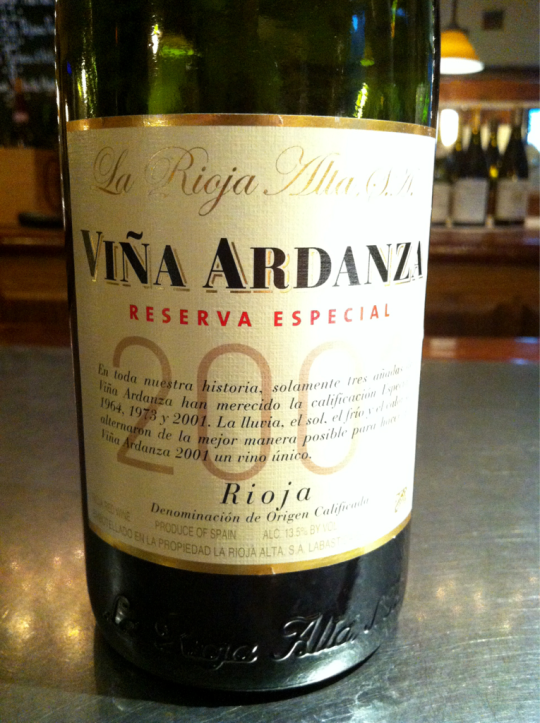
2001 Viña Ardanza Rioja Reserva Especial: One of those wines that makes me wish I had the camera with me. Classic Rioja sour cherries and raspberries, cured ham that I called "jamon", coconut, dill weed, baking spice, earth and all so perfectly balanced, integrated and layered. Moderate tannin structure and moderate acid and beautifully aged. Find this wine if you haven't tried it!
0 notes
Video
vimeo
For my first edition of Wine State of Mind on the west coast I explore Croatian Plavac Mali, an area I wasn't able to explore while in Michigan. I'm excited for my journey out here and I hope you're excited as well!
0 notes
Video
vimeo
We jump back into Wine State of Mind with another trip back to one of my favorite spots; the Loire Valley. We explore a wine from the Côtes du Forez, one of the satellite appellations that are often overlooked.
Wine Tasted in this Episode: 2011 Odile Verdier and Jacky Logel Côtes du Forez "Cuvée des Gourmets"
Links Mentioned in this Episode: Côte Roannaise Post
2 notes
·
View notes
Video
vimeo
Wines made from the slopes of Sicily's Mt. Etna have been gaining a lot of momentum lately thanks to wine writers, sellers and sommeliers alike. The wine we taste today is made by a well known importer of Italian wines who is trying his hand with this rediscovered territory.
Wines Tasted in this Episode: 2009 Tenuta delle Terre Nere Etna Rosso
Links Mentioned in this Episode: Cerasuolo di Vittoria Episode, Santorini Episode
1 note
·
View note
Video
vimeo
I was recently introduced to this style of wine by my friend Aren Stobby who recently returned from a trip to Spain. I quickly realized that this would become one of my favorite styles of wine to have with oysters, seafood or just to pair with a sunny day. Let's check this one out.
Wine Tasted in this Episode: 2010 Ulacia Getariako Txakolina (chak-oh-lee-na)
Links Mentioned in this Episode: #SatSommSmackdown - Saturday night sommelier competition
6 notes
·
View notes
Video
vimeo
We've encountered Friulano before on Wine State of Mind and today we explore a wine made by the man who wrote the book on Italian wine, Joe Bastianich. We'll see if the wine can stand up to his reputation.
Wine Tasted in this Episode: 2009 Bastianich "Adriatico" Friulano $17
Links Mentioned in this Episode: Villa Rubini Friulano, "Vino Italiano" by Joe Bastianich & David Lynch
0 notes
Link
I know this is a little late, but I still think it's pretty cool. I recently contributed to an article that ran in Culture Map Austin and Houston for recommendations for Valentine's Day wines. I am very humbled to be included in this piece with some other very esteemed wine personalities. Please excuse the first couple of paragraphs, they're a bit crude.
4 notes
·
View notes
Video
vimeo
To celebrate the 50th Episode of Wine State of Mind TV AND Valentine's Day we bring out the pink juice! Rosé is the style we started with in Episode #1 and it's also a wine that works well for VDay. Let's see how it stacks up.
Wines Tasted in this Episode: 2010 L'Astore Massoro Rosa Rosato
1 note
·
View note
Video
vimeo
Austrian wine is going to be a major talking point in restaurants and retail very soon, and even though the majority of the production is white, red wines have their place too. Zweigelt is a grape that has major potential for both wine nerds and the average drinker. These wines are both affordable and rewarding so give them some love!
Wine Tasted in this Episode: 2008 Zantho Zweigelt
Links Mentioned in this Episode: Austrian Grüner Veltliner
8 notes
·
View notes
Text
Premox: Burgundy Killer
We talk a lot about those nasty bugs, bacteria and rogue yeasts that ruin the wine that we are excited to drink and todays post is about another one of those problems. Today we discuss an issue that has been plaguing White Burgundies for almost twenty years and one that recently killed a bottle of Burgundy I opened: premature oxidation or as it is commonly referred to, "premox". No one is quite sure why after hundreds of years of quality winemaking this problem arose but it started popping up in the 1995 vintage. Some say it's faulty corks, some say it's winery hygiene but whatever it is, it's got to be stopped!
Oxidation in wine manifests itself in a couple of different ways: color and flavor, and while they often occur simultaneously they can also act independently. Color oxidation is pretty easy to recognize because the wine turns brown. Much like a banana or an apple that sits on the counter and is exposed to air, a wine's phenols (those molecules responsible for pigment) act in the same way. Now wine, whether it's red or white, will naturally move towards a brown color with age, that's okay. The problem is when you get a young wine that shows these signs. Then you have some investigation to do.
Air is also responsible for the oxidation of aromas and flavors. What happens here is the ethanol (the alcohol in wine) is oxidized by hydrogen peroxide in the wine (which is a result of the oxidized color compounds above) which in turn produces another chemical called acetaldehyde. When acetaldehyde is in great enough concentration it gives off heavy aromas of apple cider or brown apples, cereal grains like those in cheerios, and nutty aromas. The wine also has a flat sensation on the palate, lacking in flavor and structure.
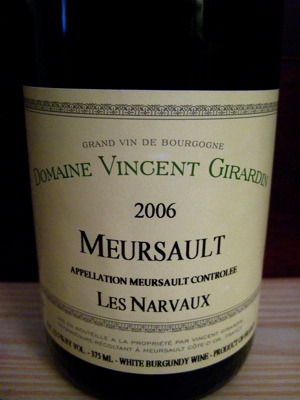
A couple of weeks ago I opened a half bottle of 2006 Vincent Girardin Meursault "Les Narvaux" that was suffering from a bad case of premox. This was one of those instances where color and flavor were acting independently. While the wine did have a darker color, Chardonnay already tends to have deeper color than other white grapes and it was six years old so it didn't seem out of place. My tasting notes follow:
Heavy marzipan and bruised apple, slight spicy note with some meyer lemon barely peaking through.
Not as expressive on palate. Dominated by spice and woody flavors, kind of harsh and flat. Alcohol is unmasked. Seems to be suffering from premox.
I was disappointed because Girardin is a producer with a lot of pedigree in Meursault. However, I soon found out, courtesy of Michael Descamps, that this particular bottling is not a stranger to premox:

I guess after this experience I'm better informed. I'll be doing research about Girardin's more recent vintages to see if they suffer from the same problem. It's okay, at the end of the day, I'd rather drink Riesling anyway.
#wine#premox#Vincent Girardin#Meursault#Burgundy#Chardonnay#Oxidation#wine flaws#Premature Oxidation
5 notes
·
View notes
Video
vimeo
Happy #PortDay! Today we celebrate a fortified wine that hasn't been getting enough love lately. We've got a Ruby Port from a very small producer in Douro that came highly recommended to me, let's see if it stacks up!
Wines Tasted in this Episode: Quinta do Infantado Ruby Port
Links Mentioned in this Episode: Red Douro Table Wines
62 notes
·
View notes
Text
"Riesling Makes You a Better Person"
The above quote comes from a favorite sommelier of mine, Paul Grieco. As the owner of Hearth Restaurant and Terroir wine bar he made it his mission to raise awareness about Riesling, a grape that is a favorite of wine nerds everywhere but is often forgotten by the general wine-drinking public. You all know that I'm a huge sucker for Riesling by now, when that juice is in my glass I just feel better.
The wine we're talking about today comes from the Mosel, probably my favorite place on Earth for Riesling. More specifically it comes from the town of Brauneberg a little further South from the more recognizable names of Ürzig, Wehlen, Zeltingen and Bernkastel. Thomas Jefferson (America's first wino) wrote about the wines from Brauneberg but it appears that they fell out of fashion (along with the majority of German wine) until the mid to late 1970s.
Well, I'm glad they're back because I was able to find this beauty recently: the 2003 Willi Haag Brauneberger Juffer Riesling Kabinett. How many white wines would you drink at nine years old? Not many I'm guessing but this one could have stood up even longer if I had the will power to put it away.
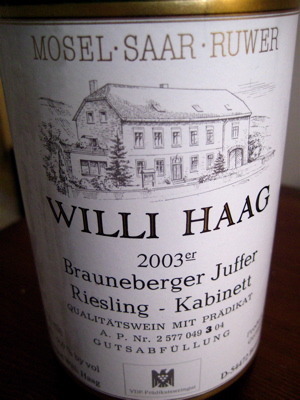
(2003 Willi Haag Brauneberger Juffer Riesling Kabinett)
The nose is an amazing mixture of orange zest, lemon, yellow apple, under ripened peach, honey, petrol and an intense minerality. What surprised me most was how round this wine was on the palate, very rich with some nectarine mixed in with the fruit from the nose and a long finish that was dominated by that minerality and honey. The acid on this wine was great and there was even an ever so slight tannic presence to it which confirmed my suspicion that this wine could be laid down even longer. Riesling is a gift of a wine and it makes you a better person, trust me.
6 notes
·
View notes
Text
New Wine Resolution: Elizabeth's Reserve Pinot Noir or Harry Potter Pinot
At the beginning of 2012 I decided that I was going to explore wines that I had previously avoided because they are very popular in the market. I did not avoid these wines because they were in any way unacceptable or underperforming, I just wanted to explore what else was out there besides what was on every wine list I came across. Well, it didn't take long for 2012 to show me what I had been missing. This year I hope to have many experiences like this so that I can become more in-tune with ALL the wine that's out there (a herculean task, but one I welcome).
Today we'll discuss Adelsheim's 2009 Elizabeth's Reserve Pinot Noir. Adelsheim is a pretty well-known producer in the Willamete Valley of Oregon but I had never had the opportunity to try one of their wines. I had always heard good things about this winery from friends in the wine business and from reviews online and whatnot so when out to dinner with some family I saw it on the wine list and thought I'd give it a shot. Everyone loves Pinot Noir, right?
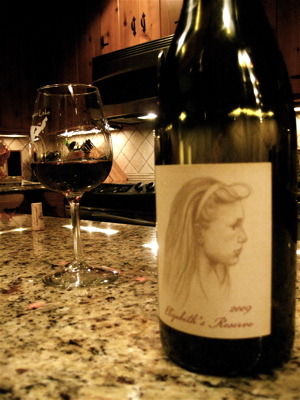
(2009 Adelsheim Elizabeth's Reserve Pinot Noir from the Willamette Valley in Oregon)
From everything I could gather, this wine is mostly made from mountain fruit, which would explain the great elegance this wine has. I haven't enjoyed a nose like this one in a long time; cranberry, strawberry, bing cherry, spice, earth, cocoa powder and even a little cannabis (no, I did not mistype) that became more pronounced as it got some air.
The best thing about this wine wasn't the flavor, it was the fact that everything was so excellently balanced, nothing stuck out like a sore thumb and even though this wine weighs in at a whopping 14.2% alcohol, that too was extremely well integrated. This is not a typical wine for me to like. It had Pinot Noir character, but it was not textbook. For one, the alcohol was higher than what is sometimes accepted for "balanced" Pinot Noir and cocoa powder is not a tell tale aroma for this particular grape (new oak treatment can be credited with that flavor), but the craftsmanship cannot be ignored.
Now, if you're as much of a nerd as I am you are probably thinking that the picture on the bottle looks a little like the portrait of Ariana Dumbledore that hangs in the Hog's Head Pub in the Harry Potter book series. Well, unfortunately, it isn't. It's a portrait of Elizabeth Adelsheim for whom the wine is named, drawn by her mother... Ginny. Now that's a little weird.
#wine#Pinot Noir#Adelsheim Vineyards#2009 Elizabeth's Reserve#Oregon#Willamette Valley#Harry Potter#Ariana Dumbledore
5 notes
·
View notes
Video
vimeo
Today, I try a wine made from Greece's most noble grape, Assyrtiko. These whites, made mostly on the volcanic island of Santorini, are extremely interesting, age-worthy and are beginning to pop up on wine lists all over America. So I decide its time to give one of them a shot!
Wines Tasted in this Episode: 2010 Domaine Sigalas Santorini
17 notes
·
View notes